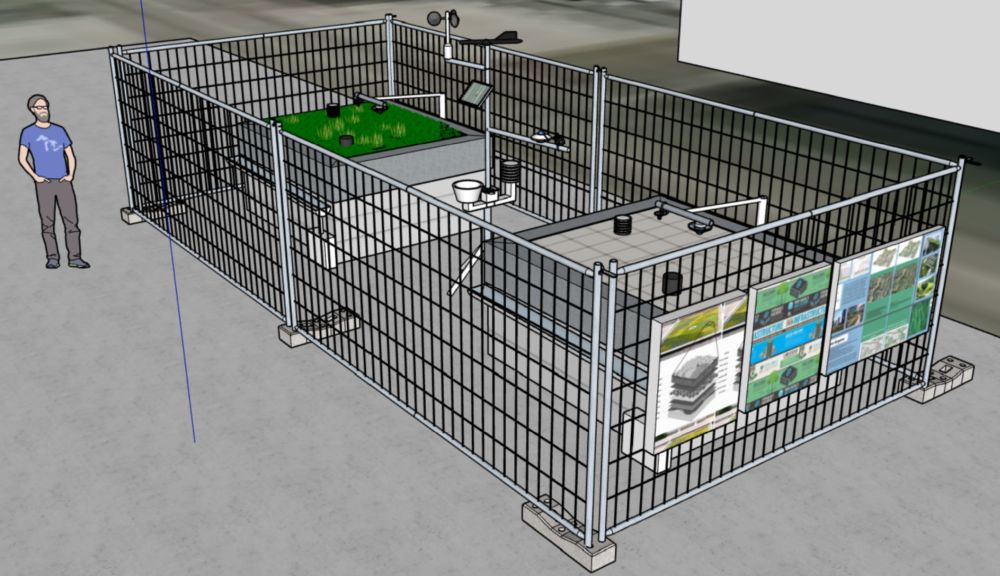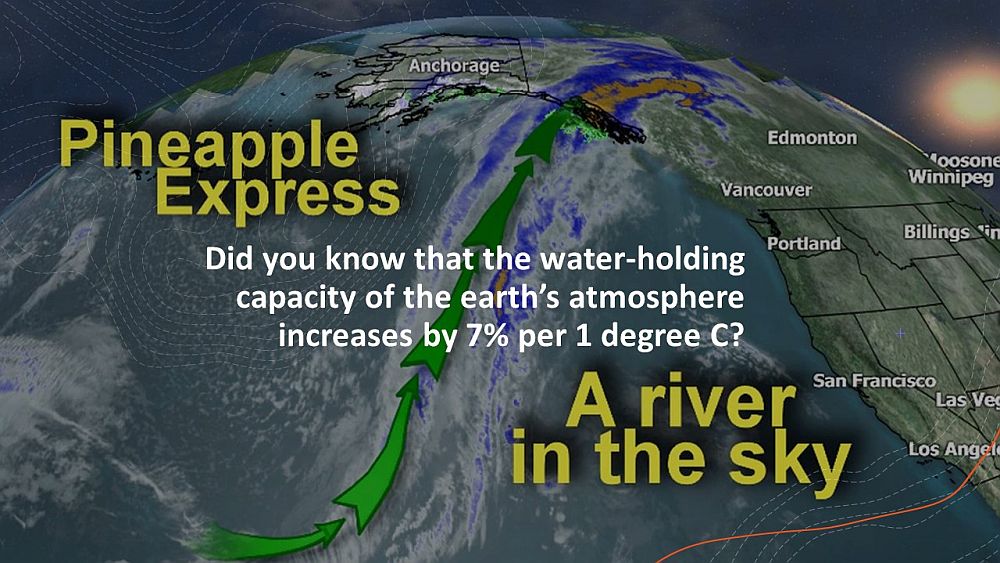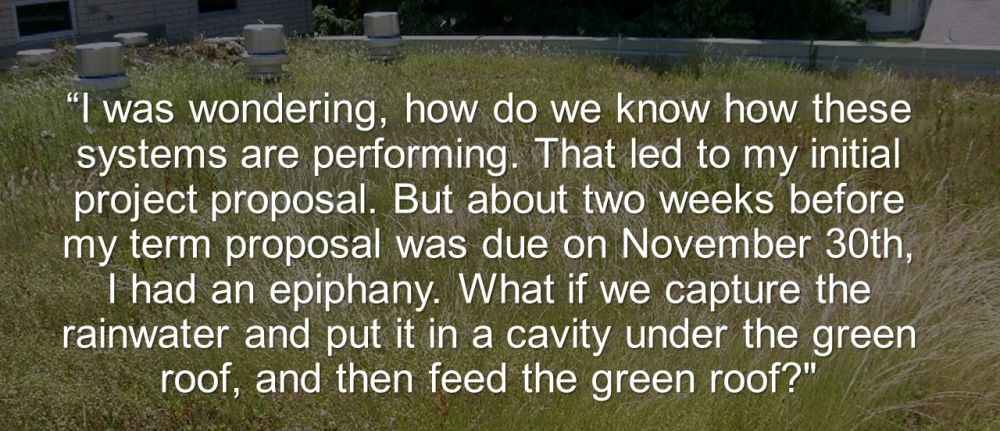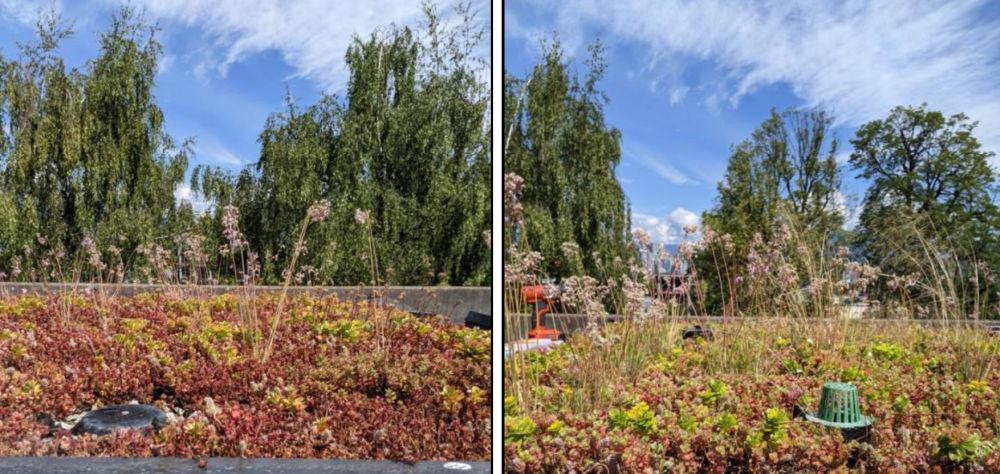LOOKING AT GREEN ROOFS THROUGH A WATER BALANCE LENS: “In 2020, our monitoring captured the heat dome. We also had a 50-plus day drought. That was great because we were able to check how the water cavity allowed the connected green roof to stay moist, longer, and more green,” stated Harvy Takhar, Utilities Engineer with the City of Delta
Note to Reader:
Waterbucket eNews celebrates the leadership of individuals and organizations who are guided by the Living Water Smart vision. The edition published on April 11, 2023 featured Harvy Takhar, an enthusiastic young professional who is the Utilities Engineer with the City of Delta. Harvy is following his passion in unexpected ways because it was happenstance that led him down the green roof pathway to international recognition.

Looking at green roofs through a water balance lens
The April 11, 2023 edition of Waterbucket eNews is an abrupt change of pace from the previous 3-part series on the Riparian Deficit. We shift our spotlight from the natural to the Built Environment with a feature on green roofs. But not from a technical perspective!
Rather, we feature the story behind the story of Harvy Takhar, an enthusiastic young professional who is the Utilities Engineer with the City of Delta. Harvy is following his passion in unexpected ways because it was happenstance that led him down the green roof pathway to international recognition.
In his quest to make a difference in the local government setting, Harvy Takhar has advanced the state of the art for green roof design. He looked through the water balance lens to conceive and demonstrate what he describes as the connected blue-green roof concept.
Fast forward to last December in Philadelphia. Harvy received the prestigious CitiesAlive International Research Award. Other types of green roofs collect and slowly release rainwater to drainage systems. His “big idea” is a novel way to transform the city environment through its roofscapes. Truly impressive.
In a nutshell, Harvy had an epiphany when he recognized there was a gap in green roof engineering. What did Harvy do? He seized the moment and that is our story behind the story. His story is fascinating.
Research on water balance performance of green roofs
“The idea was to harvest the benefits of green roofs, while keeping them healthy by storing water considering most green roofs adversely affect building systems during the drought. So we added a water cavity, known as the blue roof component, that will feed the green roof portion with capillary irrigation, and it can draw water when it needs it,” says Harvy Takhar.

Dr. Rodrigo Mora’s renderings for the green roof research assemblies with instrumentation. This version has been constructed at BCIT.
EDITOR’S PERSPECTIVE / CONTEXT FOR BUSY READER
“When I first met Harvy Takhar in late 2021, my takeaway impression was his enthusiasm. This guy is going places, I thought. At the time, he was working full-time for Delta while completing his master’s degree on green roofs in his spare time. Clearly, he is highly motivated,” stated Kim Stephens, Waterbucket eNews Editor and Partnership Executive Director.
“What I like and appreciate about Harvy is the context he provides for his green roof research. “Buildings are designed with little connection to the actual site and their surroundings, and vice versa, urban environments are environmentally disconnected from buildings,” he says.”
“The connected blue-green roof research,” Harvy continues, “aims to create a platform to train students and investigate about how to support the design of more comfortable and healthier outdoor environments, as well as how to design stronger environmental connections between buildings and their surroundings.”
“Harvy approached his research with a water balance lens. That is what caught my attention. Twenty years ago we had quantified the potential rainwater capture benefits of green roofs in Stormwater Planning: A Guidebook for British Columbia. What I learned from Harvy, however, is that neither the science nor practice of green roofs in BC had progressed since then.”
“The good news is that Harvy Takhar came along and re-energized an aspect of green roof research that had lain dormant for two decades. The takeaway is that it takes a champion, someone with passion and inspiration, to open minds to the possibilities of what could be. Well done, Harvy Takar!”
“Given how our climate is changing – with longer, drier summers being BC’s new reality – communities must adapt to a changing seasonal water balance. Harvy Takhar’s connected blue-green roof (BGR) may well prove to be an important piece in a long-term strategy for water balance management.”
“To quote Harvy, BGR systems are a novel nature-based solution for climate change adaptation and mitigation that provides multiple benefits to the urban environment.”


STORY BEHIND THE STORY: Looking at green roofs through a water balance lens – conversational interview with Harvy Takhar
“Before I joined the City of Delta, I enrolled in a master’s degree program at the BC Institute of Technology, mainly because BCIT has an excellent evening program in building engineering,” says Harvy Takhar as he reflects on his journey to date.
“Part of me was a little hesitant as I tried to see how to tie that stuff in with my current utilities role in the engineering department at Delta. The good news is that, as I discovered, in Delta there is a good cross-connection with development and planning.”
“So I enrolled in the program and did the core course work which had an emphasis on energy conservation. But I noticed that there was not much on taking advantage of rainwater. I started thinking about how we could use some of the rainwater before we pipe it out to the Fraser River and into the sea.”
“With our municipal drainage systems, we collect and pipe rainwater runoff away too fast. Part of my thinking was the need to offset irrigation. In summer, the Metro Vancouver region consumes a significant portion of our potable water supply for garden and lawn irrigation.”
“That is when my mind started thinking about this. I was in a class where we were looking at roofs. The course had one small section on green roofs and all those fun benefits such as energy reduction, biodiversity, acts like a blanket in winter so less heat, and less cooling required in summer. Some of these buildings are using the green roof as an amenity space.”

“The light bulbs started going off and I started doing some research. There was not much information. So, it felt like an ingenious idea except when I went to my professor to discuss it. How do you get the water back up, he asked. We do not want to pump because that uses energy.”
“Then I started doing more research. I was thinking in terms of something like sponge towels, that acts like capillary irrigation. They transfer water from more wet moist to less wet moist. In the summer, these green roofs would not need irrigation water and we could use some of the water we have stored from each rainfall.”
“I was trying to figure out why developers are not doing this everywhere. There were three reasons, I concluded. One, not many contractors like to install these roofs. Two is maintenance and three is the fire risk. In summer, when green roofs dry out, they pose a significant fire risk.”
“We developed this project proposal where I wanted to quantify how much rainwater runoff we could save from entering our drainage system by using it on roofs first. The proposal also included temperature sensors, an ultraviolet light reader, and so on.”
“Wonderful idea. My professor was quite enthusiastic even though he is more of an energy person. He found my idea to be fascinating. And then I did the cost estimate. $50,000 for a research thesis for a student. Not totally attractive for BCIT.”
“I felt shut down during the period January through April. I was faced with a decision. Stop and do a Master of Engineering which does not require a thesis. Or persevere and go the thesis route. I felt a bit of a spark. This is a cool idea and not much research has been done.”
What inter-municipal collaboration looks like

“We had a meeting and boom, we had donors for materials as I did a lot of cold emailing. It was almost like a plea to people about being part of the project. I contacted engineering companies and trades companies such that we had all these sponsors.”
“I was very blessed to have all these partners to help me get the project through. City of Vancouver offered the Helena Gutteridge Plaza at City Hall. We converted two planter boxes into roof assemblies. Dr. Rodrigo Mora worked diligently to get this project going from the BCIT side.”

“One planter box was a generic roof. Beside it we had a traditional green roof. The second planter box was divided into a connected green roof, which is a green roof with a water cavity underneath. Lastly, we had a blue roof which just had a water cavity so that we could get an indication of how that behaves.”
“It was a challenge, but I got them built with the help of friends. The soft launch was late November 2019 but data collection officially started on January 1, 2020. Throughout the process, we had real-world problems such as vandalism, etc., etc., and frequently had to do repairs.”
What performance monitoring revealed about the connected blue-green roof

Comparison of the green roof (left) and connected blue-green roof (right) on July 17, 2021 during the 2021 heat wave
“The connected blue-green roof did not win on an annual basis for runoff absorption. It did, however, perform extremely well from April through October. What else did we learn? The green roof dried out much, much faster. On average, about three weeks earlier. But it performed better than the connected blue-green roof during wet weather.”
“Overall for our climate, and for year round performance, we can better optimize connected blue-green roofs because their only sub-performance period was in winter. One of the recommendations for the next batch of students is to monitor the cavity in winter. My professor and I got provincial funding for a second set of assemblies at BCIT.”
“In summary, I have been fortunate to make a series of presentations, culminating in the award at CitiesAlive. It has been good exposure and has generated interest by academics. I am excited that researchers are feeding off each other. My results are very climate-specific. The good news is that the connected blue-green roof is self-maintaining. I was happy about that. And the vegetation is thriving,” concludes Harvy Takhar.
To Learn More:

TO LEARN MORE:
To read the complete story, download a PDF copy of Living Water Smart in British Columbia: Looking at green roofs through a water balance lens.
DOWNLOAD A COPY: https://waterbucket.ca/wcp/wp-content/uploads/sites/6/2023/04/PWSBC_Living-Water-Smart_Connected-Blue-Green-Roof_2023.pdf


